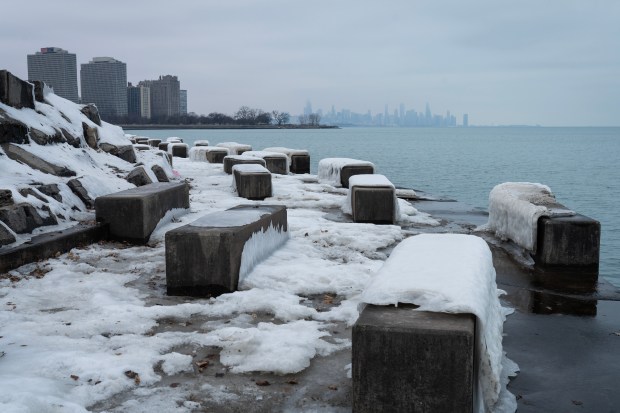The Promontory Point Conservancy released the findings of three studies Tuesday showing the limestone revetment at Promontory Point can be preserved and rehabilitated rather than replaced with concrete.
A favorite spot for many Hyde Park residents, Promontory Point, a park on the South Side, has been a community staple for more than 85 years. For decades, the community has gone back and forth with the city and U.S. Army Corps of Engineers on whether to preserve and rehabilitate the historic limestone steps which protect the point from the battering waves of Lake Michigan or replace them with concrete.
Studies conducted by McLaren Engineering Group include a coastal vulnerability analysis and alternative design options. A third study by Wiss, Janney, Elstner Associates, a historic preservation architecture and engineering firm, looks at preserving the historical structure.
Ben Komita, a coastal engineer for McLaren, said McLaren was only able to provide ideas, not necessarily specific instructions. Using a dive team and drone photography, McLaren completed an analysis, creating a 3D rendering of the revetment. The north- and east-facing areas of Promontory Point are the most vulnerable, according to the coastal study. The steps can be returned to overall good condition once support materials are restored and select limestone blocks reset, the study says.
“We can meet the goals of protecting the shoreline now and into the future, while still being considerate to the historic structure and the cultural and various community-based connections to the point,” Komita said.
Over the years, Jack Spicer, director of the Promontory Point Conservancy, said the conservancy has raised roughly $500,000 in support of preserving the point, almost entirely from small donations. Two of the studies were paid for by these contributions while the other one received a grant.
“We needed to show how does the revetment, as it stands or as it would be repaired, stand up to the requirements to protect the park from erosion,” Spicer said. “That’s what the vulnerability report did, and that was beautiful.”
Though residents have had conflicts with the city regarding the future of the revetment, local officials, including Ald. Desmon Yancy, 5th, Cook County Commissioner Bill Lowry and state Sen. Robert Peters have all voiced support for efforts to protect the limestone.
“The community has done an amazing job organizing to protect and save the point,” Peters said Monday. “The point is an important part of the history of the city of Chicago and an important part of the history of Hyde Park. The studies and science have been there this whole time. At this point, it’s about the will.”
According to Mike Padilla, senior project manager for the Army Corps who heads the Promontory Point project, the city and Army Corps are working to negotiate a memorandum with the Illinois branch of the Advisory Council on Historic Preservation, which would dictate the design for the future of Promontory Point. This agreement includes negotiations with the public before the Army Corps develops a final design and plan for the revetment.
“We definitely are committed to preserving the limestone as much as possible. When I say ‘as much as possible,’ I don’t know what that means,” Padilla said. “We haven’t started the design, and so it’s very difficult to say in big, broad strokes what we’re going to do and not do when we haven’t even started yet.”
Although there have been heated negotiations between the public and the city, Padilla said he hopes they can come to an agreement that includes what the public wants, maintains the historic structure of the point and results in the best design. He said rehabilitation makes sense, and the Army Corps always welcomes additional input, such as the findings of the studies, but the agency will need to do its own report as part of the required process for creating a design.
“There’s a lot of misinformation out there,” Padilla said. “They say that the corps and the city have a plan for concrete and steel and using limestone plating, which is just not true. We have no plan.”
Promontory Point was approved as a historic landmark in April 2023.
According to the Historic Structures Report by Wiss, Janney, Elstner, under the federal guidelines set forth by the secretary of the interior for the treatment of historic properties, the best method for treating the revetment is rehabilitation. The report details that improving access to portions of the revetment should be considered, but the primary focus should be preserving the “historic fabric and character of the original portions of the revetment.”
The Chicago Park District and its partners are committed to preserving Promontory Point in alignment with the federal guidelines, said Park District spokesperson Michele Lemons in a statement.
“The project partners have consistently and publicly expressed our commitment to saving and reusing as much of the Point’s existing limestone as possible,” Lemons said. “We will continue to work with the community, elected officials, relevant agencies, and other stakeholders to develop plans for Promontory Point from the conceptual phase through detailed design and into construction.”
In the alternative design study, McLaren offered five design options, ranging in cost from $13.7 million to $62.3 million. The design options include doing nothing to different combinations of timber, backfill and some concrete to shore up the revetment. In the same study, McLaren estimated that a design by the city and the Army Corps prioritizing sheet pile and concrete would cost approximately $100 million.
Komita said these cost estimates include basic material costs as well as production rates.
“The reports are not meant to serve as fully flushed out designs,” Komita said. “It’s meant to emphasize that installing sheet pile and pouring a concrete promenade is not the only solution. We’re not able to argue that that isn’t a solution, because it is a solution that only addresses shoreline protection. It does not pay any attention to historic preservation.”
According to Komita, the studies represent a method that the city and Army Corps may not be able to fully explore.
“They are absolutely well-informed and qualified to make decisions,” Komita said. “But sometimes there isn’t enough time within governmental bodies to be able to dedicate time to a study and be able to look at all the different applications of engineering design that could be appropriate for this site.”
Spicer hopes to leverage the support of local officials in the negotiation of the memorandum to ensure that the community’s requests are included. He said so far in negotiations, the community’s goals and the proposed ideas of the Army Corps have been completely different.
“The last meeting we had was a total disaster,” Spicer said. “We came up with our draft and then they came up with their draft, and they were totally opposite.”
Ezra Maille is a freelancer.





